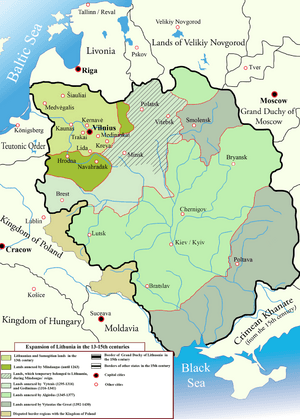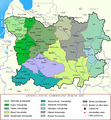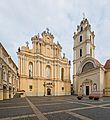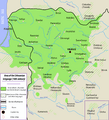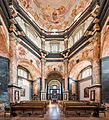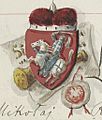Grand Duchy of Lithuania facts for kids
The Grand Duchy of Lithuania was a powerful European country that existed from the 12th or 13th century until 1569. It was founded by the Lithuanians. Over time, it grew to include large parts of what is now Belarus, Latvia, Lithuania, and even parts of Estonia, Moldova, Poland, Russia, and Ukraine.
At its largest in the 15th century, it was the biggest country in Europe. It was a very diverse place, meaning people spoke many different languages, followed various religions, and had unique cultural traditions.
The different Lithuanian lands started to come together in the late 12th century. Mindaugas was the first ruler of the Grand Duchy. He was crowned as a Catholic King of Lithuania in 1253. At that time, Lithuania was a pagan country. It was often attacked in religious crusades by groups like the Teutonic Knights and the Livonian Order.
When Gediminas became ruler, he allowed people to practice different religions. This idea of religious freedom grew even more under his son, Algirdas. Later, in 1386, Jogaila decided to change the country's main religion to Catholicism. He also created a special connection, called a dynastic union, between the Grand Duchy of Lithuania and the Kingdom of Poland. This meant the same person ruled both countries.
Vytautas the Great helped the Grand Duchy grow even larger. He also led the army that defeated the powerful Teutonic Knights in the famous Battle of Grunwald in 1410.
After Vytautas died, Lithuania's relationship with the Kingdom of Poland became difficult. To solve this, the Union of Lublin was signed in 1569. This agreement created a new, larger country called the Polish–Lithuanian Commonwealth.
Even though it was part of this new federation, the Grand Duchy of Lithuania still kept many things separate. It had its own government, its own laws, its own army, and its own treasury. However, in 1792, Russia invaded the Commonwealth. By 1795, the land of the Grand Duchy was divided up among the Russian Empire, Prussia, and Austria. This marked the end of the Grand Duchy of Lithuania as a separate state.
Images for kids
-
Poland and Lithuania in 1386–1434.
-
The Battle of Grunwald, 1410, with Ulrich von Jungingen and Vytautas at the center.
-
The Grand Duchy of Lithuania within the Polish–Lithuanian Commonwealth around 1635.
-
St. Anne's Church and the church of the Bernardine Monastery in Vilnius.
-
Constitution of 3 May, one of the first official state documents issued in both Polish and Lithuanian (Lithuanian edition).
-
Area where Lithuanian was spoken in the 16th century.
-
The Statute of Grand Duchy of Lithuania (1588) in Ruthenian printed in Vilnius.
-
The first printed book in Lithuanian, Catechism of Martynas Mažvydas by Martynas Mažvydas.
-
Lithuanian ancient hill fort in Rudamina.
-
Lithuanian ancient hill fort mounds in Kernavė, now listed as a UNESCO World Heritage Site.
-
Mir Castle - a UNESCO World Heritage Site in Belarus.
-
St. George Church (1487) in Kaunas.
-
Pažaislis Monastery church, decorated with expensive marble.
-
Royal insignias of the rulers of Lithuania in the Vilnius Cathedral, 1931.
-
"Christianization of Lithuania in 1387", oil on canvas by Jan Matejko, 1889, Royal Castle in Warsaw.
-
Priest, lexicographer Konstantinas Sirvydas, who helped preserve the Lithuanian language in the 17th century.
-
Lithuanian national coats of arms: Columns of Gediminas, Double Cross of the Jagiellonians (Jogaila) and Samogitian bear.
-
Reciprocal Guarantee of Two Nations which distinguishes Poles, Lithuanians, Ruthenians, and others, adopted on 20 October 1791.
See also
 In Spanish: Gran Ducado de Lituania para niños
In Spanish: Gran Ducado de Lituania para niños


